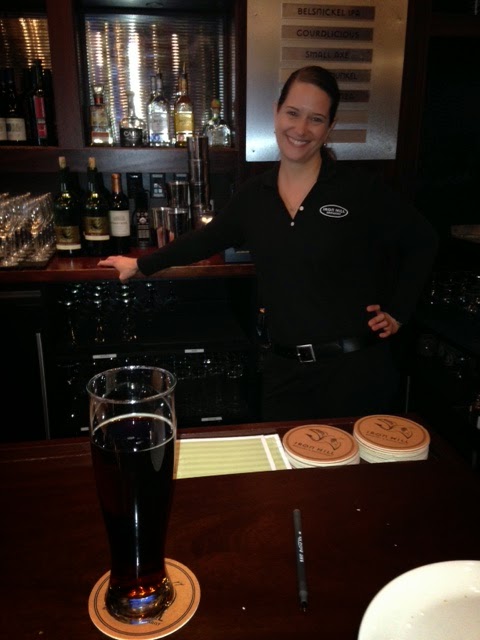The queue in this picture started forming before 11:30 on a Sunday morning last September, outside a small brewery in Ardmore, Pennsylvania. The Tired Hands Brewery would open its taproom at noon, at which time it would sell bottles--22 oz. bombers, it appeared--limit of two per person, at a rate of $25 for the pair. The beer, lost my notes but pretty sure of this, was a barrel-fermented saison with the improbable name of The
Emptiness Is Not Eternal. Ingredients included sorrel, dandelion pedals, and wildflower honey. Brewery staff had something like 250 bottles on hand to sell and that represented the entire batch--when the 125th person in the line bought his or her two bottles, that was it until the brewers might feel like making another batch. Now this is what most folks would call a cult brewery, like Black Raven in Seattle, Russian River in Santa Rosa, etc.
Got back to Tired Hands recently, and saw crowds waiting for seats early on a Saturday afternoon; no limited releases, just there for what was on tap. I had heard they had impassioned followers, and got to wondering what makes a cult brewery tick, besides great beer? Is it the longest lines at the most prestigious festivals, like the GABF or the main festival in one's state? I found a fine blog post written last September by the owner of Modern Times Brewing near San Diego, Jacob. "Let me be blunt," he writes,"there simply is not room for an infinite number of standard production breweries (like Modern Times), and even if there were, it would make for a boring beer scene."
Jacob describes four business models he considers under-utilized in craft brewing, and places Tired Hands by name in one of them. The models are (1) a business modeled after the cult winery, tasting room and shipments to paid subscribers, no distribution to other sales outlets; (2) the gastrobrewpub, where an upscale dining experience is the main draw; (3) the single-brand brewer (Mac and Jacks in Redmond and Trumer in Berkeley are the cited examples, although each makes styles other than their flagship amber and pilsner, respectively; and (4) the style specialist, building a reputation on brewing within a particular sub-genre of beer. He lauds Tired Hands and one or two others as"focused on saisons and brett-spiked beers", although that example would not exhaust the category. In our area, we have brewers who focus us German lager styles (Chuckanut, Orlison, Alpine come to mind) and the more mainstream abbey styles of Belgium (Sound, Ramblin; Road, Wander). Other ways to define a niche could include cask-only dispensing (Machine House Brewing) and organic brewing (Laurelwood, Elliott Bay, Aslan).
So what kind of tap list was Tired Hands running a few days ago? Well, they had three IPAs on hand, called Luminescent, There Is Light,and There Is Dark. I started out at a lower hop-point, with a Gose called Fickle Constitution (3.75% abv). The process is described as
follows: After the grains are steeped in the initial boil, the wort is cooled to around 115 degrees F and held at that point overnight to enable the lactobacillus to launch fermentation in a souring process. The brewer then pitches the yeast, house ale yeast, to move on to dry fermentation.
All this takes place in a seven-barrel system shoehorned into the back of the taproom, in a space converted from a doctor's office. The owner, Jean Broillet IV, is building a twenty-barrel system a few blocks away that will make life somewhat easier for brewers and waitstaff alike. Yes, there is food to go with the beer; bread baked daily on the premises (!) and charcuterie and pickles from local producers. I enjoyed a couple of slices of this bread (sourdough, of course) with a bit of finocchiona to go with the Gose, a bright, clear, tart beer.
The next treat was a glass of Apparent Ego Yard Sale, the eminently trademarkable name of their strong Berliner Weisse (7.2%). Again, souring had been launched by the eager lactobaciilus that comes right off the hulls of the barley grains, and the dry fermentation was continued with the house ale yeast. More bread, with an excellent dill pickle this time, readied my palate for the Apparent Ego etc. This had a cloudy gold look, a very floral aroma, a nice flavor of apricots on the tongue, and a long-lasting pleasant aftertaste.
Tired Hands had announced limitations on growler fills on their website around the holidays. Another aspect of cult brewing is creating a notion of shortage--there's only so much of this beer on hand, folks; when it's gone it's gone for months. But here in the third week of January, I saw several customers getting two or three growlers filled. Perception of limited supply drives demand, yes, economists?
(Visited 9/21/14, 01/16/15)












